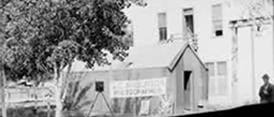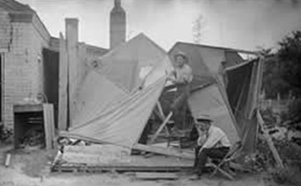George Edward Anderson Collection
About the Collection
Biography of George Edward Anderson, 1860–1928
George Edward Anderson1 (Ed, as he was called) was born 28 October 1860 in Salt Lake City and apprenticed as a teenager under renowned photographer, Charles R. Savage. It was at Savage’s Temple Bazaar that he became friends with fellow apprentices John Hafen and John F. Bennett. Hafen was later to become an accomplished artist and Bennett was to be instrumental in preserving Anderson’s collection of glass plate negatives.
At the age of seventeen Anderson established his own photography studio in Salt Lake City with his brothers, Stanley and Adam. He subsequently established a studio in Manti, Utah in 1886 and in the fall of 1888 he moved his studio to Springville, Utah with his bride, Olive Lowry.

He is perhaps best known for his traveling tent studio, set up in small towns throughout central, eastern, and southern Utah to capture the lives of the residents. These studios thrived throughout the years 1884–1907.
Although today we might think of Ed Anderson as a portrait photographer, his clear and artistic studio portraits are complemented by thousands of documentary portraits taken near homes, barns, and businesses. They document not only families but also small town Utah history. He documented, among other things, railroad history, mining history including the Scofield mine disaster, and the building of temples by members of the Church of Jesus Christ of Latter-day Saints2. Pure landscape photographs were never his interest, but to many Church members his 1907–1908 photographs of Church history sites are their only acquaintance with Anderson’s art. He photographed these sites while traveling across the country to begin his LDS Church mission in England from 1909–1911. The Deseret Sunday School Union of the Church published some of the views, as Anderson called them, in a booklet entitled The Birth of Mormonism in Picture.
Upon completion of his mission Anderson returned to South Royalton, Vermont and set up a photography studio near the birthplace of the prophet Joseph Smith. He added a number of Church history site photographs, as well as portraits of Church members and local residents to his growing collection. Finally, in November 1913 he returned to his family and home in Springville, Utah.

After a seven year absence his photographic business was unhealthy and his family life was strained. But business and money were never the motivating forces of Ed Anderson’s life —art and religion were his driving forces.3 Continuing to experience financial and marital strains, Anderson tried to revive his traveling tent studio but met with little success. He was, however, able to earn some money from the sale of The Birth of Mormonism booklet.4
The later years of Ed Anderson’s life were spent in documenting families and life in Utah Valley and traveling to newly constructed temples. In 1923 he traveled to Cardston, Alberta, Canada with Church authorities for the dedication of that city’s temple. He was to spend two years in Canada, returning to Springville in 1925.
Though ill in the fall of 1927, and despite his wife’s urging not to go, Anderson went once again with Church officials to document the dedication of another temple, this time in Mesa, Arizona. It was to be his last trip. He died of heart failure on 9 May 1928 after being brought home to Springville.
Essentially unsung as a photographer during his lifetime, only in the last 30 years has Anderson been recognized for the consummate photographic artist that he was. Primarily, the work of Rell G. Francis along with Nelson Wadsworth and Richard Holzapfel, has brought his exquisite work to the attention of this generation.
Charles Reynolds, picture editor of the magazine Popular Photography, commented at a Brigham Young University photo seminar on 11 December 1973 about his introduction to Anderson’s photographs. After attending an exhibition at the Springville Museum of Art, arranged by Rell Francis, he had this to say: “I go to shows several times a week in New York City … and I have rarely seen anything as impressive as those photographs… . It is awfully hard to astonish me… . The George Anderson pictures that I saw today weren’t sensationalized pictures in any way. They were very sweet, beautiful, lovely pictures… .”5
Footnotes
- Note: The majority of this biographical information is taken from Rell G. Francis. The Utah Photographs of George Edward Anderson. Lincoln: University of Nebraska Press, 1979.
- Hereafter referred to as the LDS Church or Church.
- Francis, p. 3.
- Ibid., p. 24.
- Charles Reynolds, photo seminar, 11 December 1973, typescript from a recording made by the BYU Communications Department.
